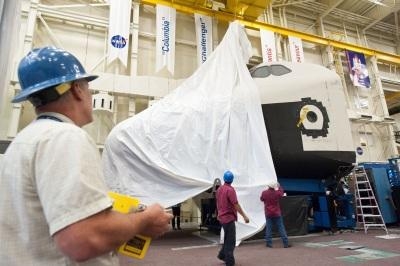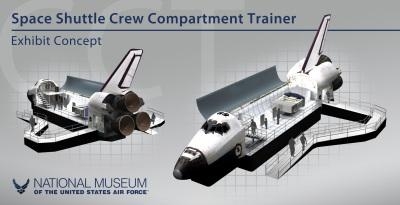Museum Plans Payload Bay Mockup To Give Visitors Full Shuttle Experience
After many months of intensive planning, the first steps have been put in motion to move NASA's first Shuttle Crew Compartment Trainer from Johnson Space Center to the National Museum of the U.S. Air Force. CCT-1, which was one of three trainers built to train astronauts for space missions, is scheduled to arrive at the museum, which is located at Wright-Patterson Air Force Base, Ohio, later this summer.

For more than 30 years, CCT-1 was housed in Johnson Space Center's Space Vehicle Mockup Facility in Houston. It was used to train crews from STS-1 through STS-135 as a high-fidelity representation of the Space Shuttle Orbiter crew station for on-orbit crew training and engineering evaluations. Using the trainer, astronauts learned how to operate many of the orbiter sub-systems in more than 20 different classes.
In order to prepare the more than 24,000-pound trainer for flight to the museum, engineers first needed to design a specialized adapter to allow it to be transported on NASA's Super Guppy aircraft. According to Jill MacGregor, the Space Vehicle Mockup Facility mockup manager, planning to move an object that wasn't designed to be moved again after it had arrived at Johnson Space Center has proven quite challenging.
"Really the most difficult part of moving the CCT-1 is coordinating all of the different parties involved," said MacGregor. "You've got folks from Johnson Space Center transportation who are going to box-up all of the small items; you've got JSC Riggers who do all of the lifting and the truck moves; you have aircraft loadmasters and engineers who have to be involved with how to orient the trainer into the aircraft, how to chain it down and how to analyze all of the loads to make sure it flies safely."
The shipping process began with the removal of all of the items from the inside of CCT-1, which will be shipped to the museum separately. The trainer was then recently shrink-wrapped to protect it from the elements. Current plans call for CCT-1 to be loaded onto a truck soon and stored in the nearby Light Manufacturing Facility. From there, the CCT-1 will be transported to Ellington Field Joint Reserve Base in Texas in preparation for its flight to Ohio. At that time, it will be mounted to the adapter and flown to the museum.

"CCT-1 was designed to turn vertical and it has some structure on the bottom that is not even, so that makes it a challenge to put it on a truck and drive it up to Ellington Field while keeping it low enough to the ground to avoid hitting trees along the way," MacGregor said. "And all of the moves have to be done in the middle of the night because of traffic concerns."
After arrival, museum and NASA technicians will offload the trainer, reassemble the interior and place it on interim display in the Cold War Gallery. Later, CCT-1 will be moved to a new Space Gallery in the museum's planned fourth building.
According to retired Lt. Gen. Jack Hudson, the director of the National Museum of the U.S. Air Force, the CCT-1 will be a great addition to the museum because the Air Force has been a major partner with NASA in space. "CCT-1 will really help us tell the story of the Air Force in space, and by doing that it will motivate, educate and inspire our youth toward the Air Force as well as in careers in science, technology, engineering and math," said Hudson.
According to Hudson, plans call for the museum to build a mock-up of the payload bay and when the CCT-1 exhibit is completed, it will allow the public to have a look into the cockpit and mid-deck areas of a shuttle and learn how astronauts trained for their missions. "Visitors will actually be able to walk up inside the payload bay mockup and see everything up close, and also really get an idea what the crew station was like, how big it was and how it was designed," Hudson said.
The new Space Gallery, where the CCT-1 will eventually reside, is a part of a multi-phase, long-term expansion plan and will house the museum's growing space collection. The gallery will include a Titan IV space launch vehicle, Mercury, Gemini and Apollo spacecraft, and many recently retired NASA artifacts such as a nose cap assembly, landing gear strut and a variety of astronaut equipment.
(Images provided by the U.S.Air Force)
 ANN's Daily Aero-Term (04.14.24): Maximum Authorized Altitude
ANN's Daily Aero-Term (04.14.24): Maximum Authorized Altitude ANN's Daily Aero-Linx (04.14.24)
ANN's Daily Aero-Linx (04.14.24) Classic Aero-TV: 'We're Surviving'-- Kyle Franklin Describes Airshow Life 2013
Classic Aero-TV: 'We're Surviving'-- Kyle Franklin Describes Airshow Life 2013 Aero-News: Quote of the Day (04.14.24)
Aero-News: Quote of the Day (04.14.24) Airborne 04.09.24: SnF24!, Piper-DeltaHawk!, Fisher Update, Junkers
Airborne 04.09.24: SnF24!, Piper-DeltaHawk!, Fisher Update, Junkers




